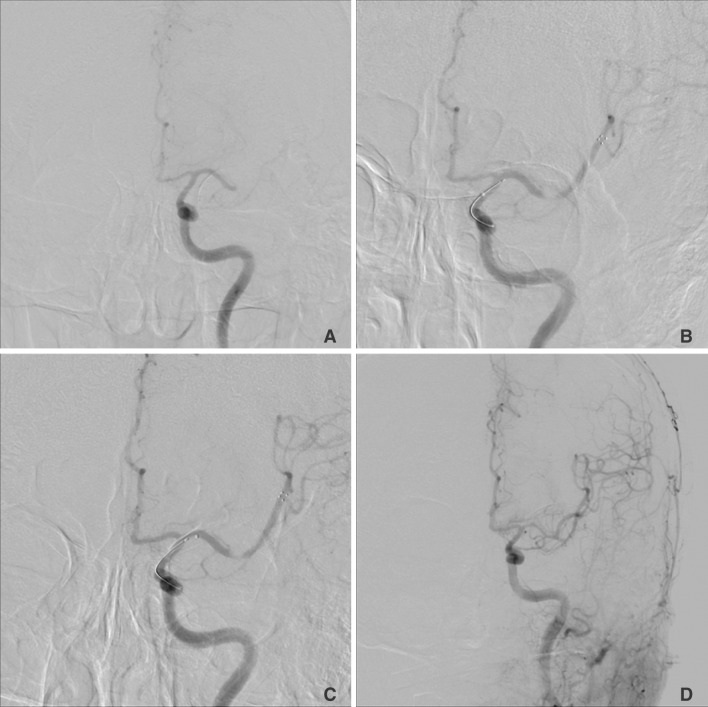Neurointervention.
2016 Sep;11(2):114-119. 10.5469/neuroint.2016.11.2.114.
Mechanical Solitaire Thrombectomy with Low-Dose Booster Tirofiban Injection
- Affiliations
-
- 1Department of Neurosurgery, Hanmaeum Changwon Hospital, Changwon, Korea.
- 2Department of Neurosurgery, Inje University Haeundae Paik Hospital, Busan, Korea. kusmal@hanmail.net
- 3Department of Radiology, Inje University Busan Paik Hospital, Busan, Korea.
- 4Department of Neurology, Inje University Haeundae Paik Hospital, Busan, Korea.
- KMID: 2350689
- DOI: http://doi.org/10.5469/neuroint.2016.11.2.114
Abstract
- PURPOSE
Mechanical thrombectomy using a Solitaire stent has been associated with a high recanalization rate and favorable clinical outcome in intra-arterial thrombolysis. To achieve a higher recanalization rate for mechanical Solitaire thrombectomy, we used an intra-arterial low-dose booster tirofiban injection into the occluded segment after stent deployment. We report the safety and recanalization rates for mechanical Solitaire thrombectomy with a low-dose booster tirofiban injection.
MATERIALS AND METHODS
Between February and March 2013, 13 consecutive patients underwent mechanical Solitaire thrombectomy with low-dose booster tirofiban injection. The occlusion sites included the proximal middle cerebral artery (5 patients), the internal carotid artery (5 patients), the top of the basilar artery (2 patients) and the distal middle cerebral artery (M2 segment, 1 patient). Six patients underwent bridge treatment, including intravenous tissue plasminogen activator. Tirofiban of 250 µg was used in all patients except one (500 µg). All occluded vessels were recanalized after 3 attempts at stent retrieval (1 time, n=9; 2 times, n=2; 3 times, n=2).
RESULTS
Successful recanalization was achieved in all patients (TICI 3, n=8; TICI 2b, n=5). Procedural complications developed in 3 patients (subarachnoid hemorrhage, n=2; hemorrhagic transformation, n=1). Mortality occurred in one patient with a basilar artery occlusion due to reperfusion brain swelling after mechanical Solitaire thrombectomy with low-dose booster tirofiban injection. Favorable clinical outcome (mRS≤2) was observed in 8 patients (61.5%).
CONCLUSION
Our modified mechanical Solitaire thrombectomy method using a low-dose booster tirofiban injection might enhance the recanalization rate with no additive hemorrhagic complications.
Keyword
MeSH Terms
Figure
Reference
-
1. Nogueira RG, Lutsep HL, Gupta R, Jovin TG, Albers GW, Walker GA, et al. Trevo versus merci retrievers for thrombectomy revascularisation of large vessel occlusions in acute ischaemic stroke (trevo 2): a randomised trial. Lancet. 2012; 380:1231–1240. PMID: 22932714.
Article2. Saver JL, Jahan R, Levy EI, Jovin TG, Baxter B, Nogueira RG, et al. Solitaire flow restoration device versus the merci retriever in patients with acute ischaemic stroke (swift): a randomised, parallel-group, non-inferiority trial. Lancet. 2012; 380:1241–1249. PMID: 22932715.
Article3. Miteff F, Faulder KC, Goh AC, Steinfort BS, Sue C, Harrington TJ. Mechanical thrombectomy with a self-expanding retrievable intracranial stent (solitaire ab): Experience in 26 patients with acute cerebral artery occlusion. AJNR Am J Neuroradiol. 2011; 32:1078–1081. PMID: 21493763.4. Dorn F, Stehle S, Lockau H, Zimmer C, Liebig T. Endovascular treatment of acute intracerebral artery occlusions with the solitaire stent: Single-centre experience with 108 recanalization procedures. Cerebrovasc Dis. 2012; 34:70–77. PMID: 22759754.
Article5. Jeong HW, Jin SC. Intra-arterial infusion of a glycoprotein IIb/IIIa antagonist for the treatment of thromboembolism during coil embolization of intracranial aneurysm: a comparison of abciximab and tirofiban. AJNR Am J Neuroradiol. 2013; 34:1621–1625. PMID: 23660289.
Article6. Kwon JH, Shin SH, Weon YC, Hwang JC, Baik SK. Intra-arterial adjuvant tirofiban after unsuccessful intra-arterial thrombolysis of acute ischemic stroke: Preliminary experience in 16 patients. Neuroradiology. 2011; 53:779–785. PMID: 21808986.
Article7. Seitz RJ, Siebler M. Platelet GPIIb/IIIa receptor antagonists in human ischemic brain disease. Curr Vasc Pharmacol. 2008; 6:29–36. PMID: 18220937.
Article8. Seitz RJ, Hamzavi M, Junghans U, Ringleb PA, Schranz C, Siebler M. Thrombolysis with recombinant tissue plasminogen activator and tirofiban in stroke: preliminary observations. Stroke. 2003; 34:1932–1935. PMID: 12829861.9. Noser EA, Shaltoni HM, Hall CE, Alexandrov AV, Garami Z, Cacayorin ED, et al. Aggressive mechanical clot disruption: a safe adjunct to thrombolytic therapy in acute stroke? Stroke. 2005; 36:292–296. PMID: 15625300.10. Berger C, Fiorelli M, Steiner T, Schabitz WR, Bozzao L, Bluhmki E, et al. Hemorrhagic transformation of ischemic brain tissue: asymptomatic or symptomatic? Stroke. 2001; 32:1330–1335. PMID: 11387495.
- Full Text Links
- Actions
-
Cited
- CITED
-
- Close
- Share
- Similar articles
-
- Adjuvant Tirofiban Injection Through Deployed Solitaire Stent As a Rescue Technique After failed Mechanical Thrombectomy in Acute Stroke
- The Limitations of Thrombectomy with Solitaire(TM) AB as First-line Treatment in Acute Ischemic Stroke: A Single Center Experience
- Safety and Efficacy of Mechanical Thrombectomy with Solitaire Stent Retrieval for Acute Ischemic Stroke: A Systematic Review
- Treatment of the Superior Sagittal Sinus Thrombosis with the Mechanical Thrombectomy Using Stent-Retriever Device
- How to Escape Stentriever Wedging in an Open-cell Carotid Stent during Mechanical Thrombectomy for Tandem Cervical Internal Carotid Artery and Middle Cerebral Artery Occlusion


